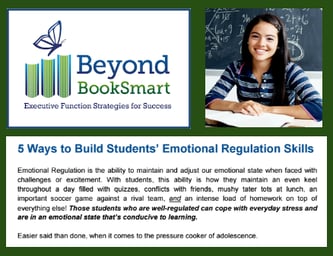A couple of years ago I learned the secret to getting a group of sixth graders to participate in class:  simply ask them if they are stressed out. This was my icebreaker question and the prelude to teaching mindfulness as a method to help students reduce stress. In response, it seemed as though the entire class raised their hands. And there was not enough time to allow everyone to share what stressed them out. These results were repeated with each class that I taught.
simply ask them if they are stressed out. This was my icebreaker question and the prelude to teaching mindfulness as a method to help students reduce stress. In response, it seemed as though the entire class raised their hands. And there was not enough time to allow everyone to share what stressed them out. These results were repeated with each class that I taught.
Sixth grade, the first year of middle school for many students, can be particularly stressful - and the stress seems to increase with age. These stressors are also beginning earlier and earlier. It is common for elementary students to have tight schedules consisting of homework and extracurricular activities. However, the Executive Function skills students need to manage these stressors are not necessarily taught formally. We don’t expect students to “figure out” how to read, so why should we expect them to “figure out” how to regulate their emotions, develop cognitive flexibility, learn how to plan and prioritize, and to develop other Executive Function skills? I wondered, could teaching mindfulness be a useful way to improve their ability to self-manage?
What is Mindfulness?
First we need to better understand what mindfulness is. According to Jon Kabat-Zinn, the founder of Mindfulness-Based Stress Reduction (MBSR), “Mindfulness is awareness that arises through paying attention, on purpose, in the present moment, non-judgmentally.” This refers to awareness of what is happening inside of a person (thoughts, feelings, bodily sensations) as well as what we sense when interacting with the world around us through our five senses (sight, smell, taste, touch, sound).
Studies have found that programs teaching children mindfulness are associated with improved Executive Function skills in children who had deficits in these areas. Areas of Executive Function that showed gains were: attention, impulse control, working memory, cognitive flexibility, and emotion regulation. Of course, while helping a child develop mindfulness may help with these areas, it is not a panacea and should not be expected to “cure” problematic behaviors.
Can a parent teach mindfulness to their child?
Not only did developing my own practice help me to better teach mindfulness, it ended up being a truly life changing experience for me. One way you can learn to do this is to take an eight week MBSR course.
You may be concerned that you don’t have time or the inclination to develop your own mindfulness practice. Using short exercises, you can begin to develop mindfulness with your child at home. As Sharon Salzberg says, “If you can breathe, you can meditate.”
Ways to incorporate mindfulness activities into your child’s life
Apps- Apps are a great tool to use with students, since they typically enjoy using technology. Headspace, Calm, and Smiling Mind are apps that my students have liked. Different students prefer different apps, so it’s good to know there are many choices available. Encourage your child to try a few in order to find the best fit. Headspace’s guided meditations are 10 minutes each, and Calm has slightly shorter ones. Smiling Mind offers different meditations depending on a child’s age. Additionally, Smiling Mind allows greater choice when deciding on the type of meditation to use.
Websites- Gonoodle.com and calm.com are great resources for parents to use when looking for short mindfulness activities. Headspace also has a website that functions similarly to the app.
Yoga- If you enjoy yoga or have been thinking about trying it, consider bringing your child with you if the instructor allows it. Some adult yoga classes permit children to participate with their parents. There are also yoga classes only for children.
Scripts- There are many activities and scripts available for parents to use with their children when teaching mindfulness. Here are a few that might be helpful.
- Breathing Buddies- Daniel Goleman explains how to teach students mindful breathing using stuffed animals in this YouTube clip.
- Mindful Eating- Many mindfulness programs incorporate the mindful eating of a raisin or chocolate kiss. Here is YouTube video to ---> teach your child how to eat something mindfully.
- Spiderman Meditation- For superhero fans, this mindfulness activity uses a Spiderman script to walk you through teaching your child to become aware of what he/she is sensing with all five senses.
Mindfulness exercises are an effective way to help students self-regulate. Furthermore, when students become more mindful, it opens the path toward improved Executive Function skills. Remember those stressed 6th graders at the beginning of this article? Students I've worked with have shared with me how mindfulness apps have improved their productivity, focus, and sleep as well as reduced stress.
It’s good to know that teaching students mindfulness can help move them toward gaining skills that instill confidence and calmness in the face of increased expectations.
Looking for more strategies to help your child manage stress? Click the button under the image below to download our 5 tips for emotion regulation.
Leora Tanzman is an Executive Function coach for Beyond BookSmart and a school psychologist. She has over five years of experience working with students to improve skills needed to succeed academically and socially. Her experience with learners from a range of cultures, ages, and learning abilities has enabled her to be a more flexible teacher. In her free time, she enjoys practicing mindfulness, yoga, painting, and photography.


